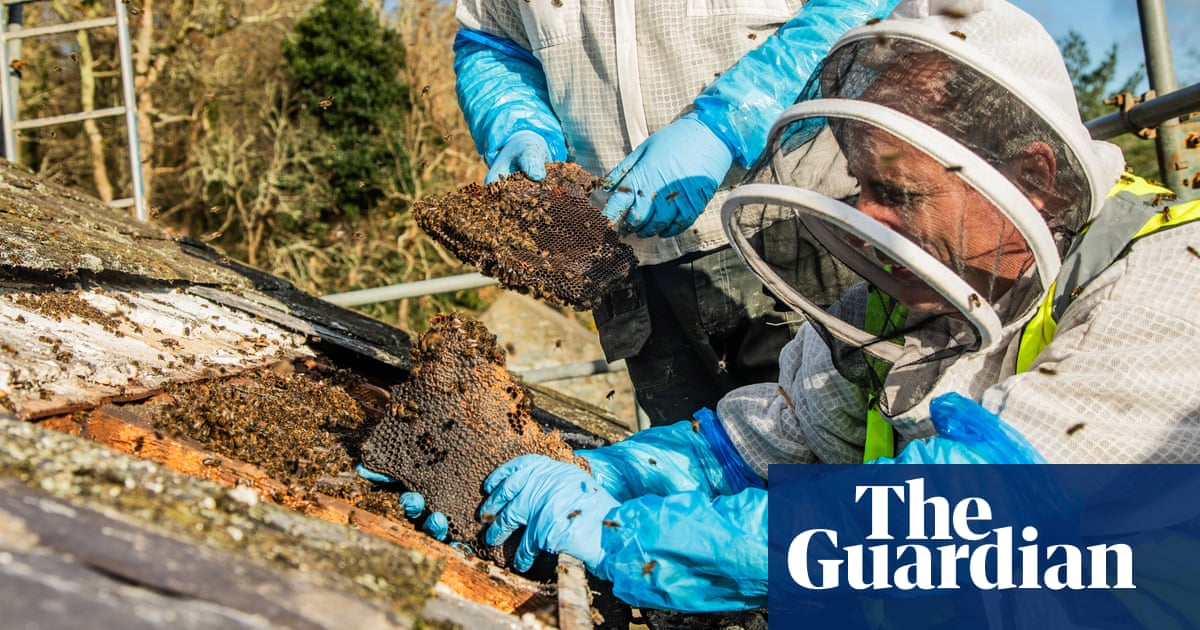
When the 17th-century manor house in the far north-west of Wales was bequeathed to the National Trust, it came with a clear condition: the bees in the roof, which sometimes produce so much honey that it oozes through cracks in the walls, should be left alone.
However, the ravages of the wind and rain mean the slate roof of the house, Plas yn Rhiw, on the Llŷn peninsula, needs to be replaced and so about 50,000 rare Welsh black bees have been given a temporary home while the work is done.
Mary Thomas, property operations manager at the house, said: “They were moved around 10 miles away – if they had been closer they may have come straight back. In the late spring they will be returned to the house’s orchard in the hives they are living in now and the idea is they will find their way back to the roof.”
Plas yn Rhiw was rescued from neglect and lovingly restored by three sisters, Eileen, Lorna and Honora Keating, after they acquired it in 1938.
In 1952, the sisters placed the house in the care of the National Trust with the condition that the bees in the roof should be cared for, stating: “We earnestly wish that the wild bees be undisturbed. May all occupiers of the property be requested to refrain from using poisonous sprays and preparations for the control of pests and advice on harmless methods be sought.”
While Plas yn Rhiw lies in its own micro-climate on the Llŷn peninsula and is generally milder than other parts of north Wales, during the winter months it can be battered by high winds and heavy rainfall.
Over the last 200 years, the roof has been repaired in small patches but recent severe weather has caused it to deteriorate, hence the need for a completely new roof.
The work is being carried out in sections with the old slates reused where possible as well as more than 4,000 new Welsh slates from the Penrhyn quarry in north Wales, once the largest slate quarry in the world.
Thought to have died out in all but the most remote parts of northern Britain, black bees were rediscovered in 2012 including in north Wales. The trust said the the Welsh black honey bee was a subspecies of the black honey bee.
A specialist company called SwarmCatcher was used to collect the bees from the roof and move them to hives nearby.
Thomas said: “The Keating sisters were very fond of nature and wildlife and were ardent supporters of the Council for the Protection of Rural Wales.
“When the Keatings restored the house, they made it a home for more than just themselves. Along with rabbits in the garden and badgers in the woodland, the bees living in the roof were welcome and remain so today, even when we occasionally have honey oozing from cracks in the walls in the summer.”
The trust said it was uncommon to find bees in roof spaces, and they were more used to working out how to protect bats during roofing projects.
Plas yn Rhiw is home to common pipistrelle, soprano pipistrelle and whiskered bats, which are also being protected during the re-roofing project. In addition to maintaining access for the bats that roost in the roof, additional small gaps around the eaves and under the slates at the ends of the building will be carefully added so the bees can return to their old home.
Once completed, it is hoped the watertight roof will allow the house to become more energy-efficient and reduce the humidity risk to the collection and redecoration of the rooms.
The garden and parkland will reopen on 20 March, but the house itself will remain closed as conservation work continues.












